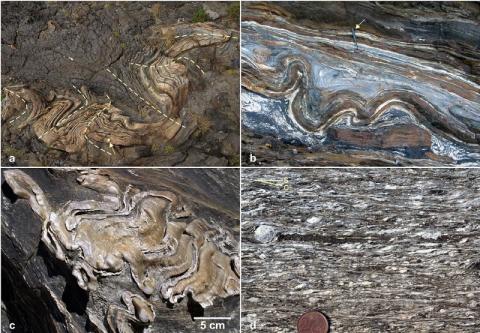Sebastián Oriolo, Bernhard Schulz, Mathias Hueck, Pedro Oyhantçabal, Florian Heidelbach, Graciela Sosa, Alfons van den Kerkhof, Klaus Wemmer, Haakon Fossen, Elena Druguet, Jens Walter, Carolina Cavalcane, Siegfried Siegesmund
2 022
Earth-Science Reviews 234 (2022)
The concepts of progressive and polyphase deformation have been widely applied by structural geologists to explain complexly deformed rocks, particularly for ductile conditions. Interpreting complex structural patterns as the result of progressive deformation is mainly based on structural and kinematic evidence, applying the Ockham’s razor principle: single-phase progressive deformation is the simplest and thus most plausible explanation in many cases. Processes such as strain partitioning and localization are commonly considered to explain such patterns. In this contribution, guidelines to distinguish between progressive and polyphase deformation processes are presented, mainly based on a critical discussion of advantages and pitfalls of P-T-D-X-t (pressure – temperature – deformation – composition – time) data. Such information not only allows for a robust reconstruction on the timing and rates at which deformation operates, but also provides insights into the progressive or polyphase evolution of pressure-temperature conditions and fluid flow. For example, complex structural patterns are common in transpressional and transtensional settings, particularly (but not only) for non-steady progressive deformation, which seems to be the rule in nature. Consequently, assessing the structural and microstructural context is a must, because analytical data commonly record only distinct stages in the protracted evolution of deformation. CPO data are useful to disentangle complex structural histories, particularly in the case of changing deformation mechanisms and related conditions. For petrochronology, it is thus highly relevant to understand equilibrium conditions and mechanisms of intracrystalline deformation and (re)crystallization of dated minerals, in order to properly link the obtained ages with specific deformation stages and mineral reactions. In a similar way, structural facies characterization is critical to interpret geochronologic data linked to ductile and brittle deformation. Though poorly explored, microstructural information of fluid inclusion data is a valuable tool to understand the role of fluids in deformation-assisted settings. The recognition of phases is ultimately related to their tectonic significance and, therefore, may not be easy in cases of overlapping tectonic processes (e.g., subduction during a post-collisional phase) and transitional stages that may not necessarily imply a dramatic change in the deformation pattern (e.g., post-orogenic collapse and intracontinental rifting).

